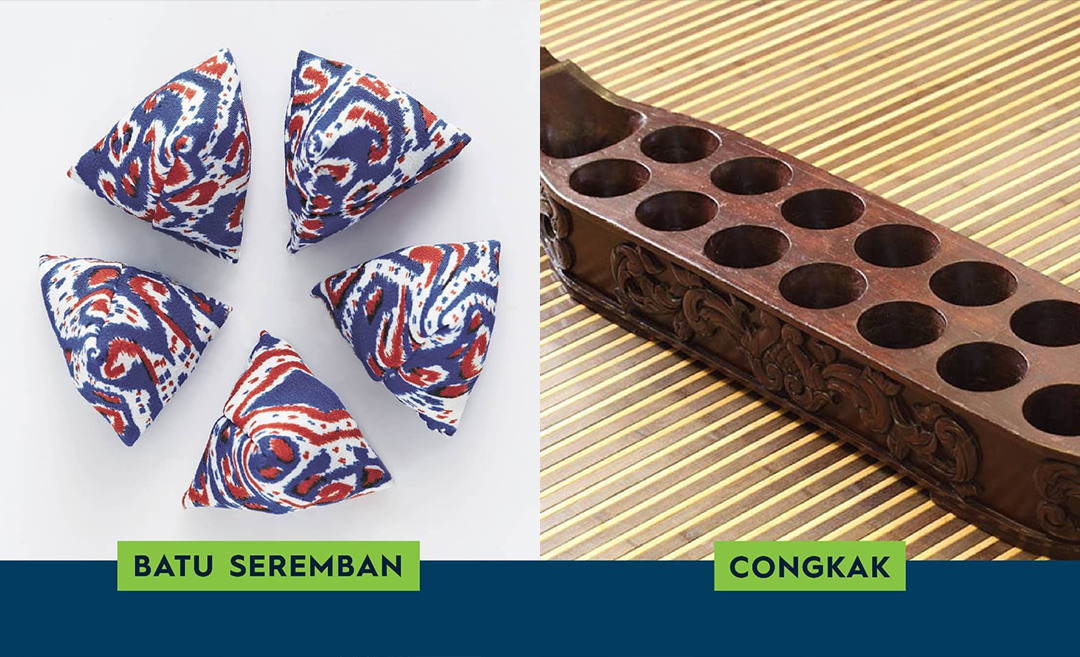We now live in a very digitally-dependant era, where kids prefer text over phone calls, video games versus board games, and of course, let’s not forget the constant updates on social media. But before these digital devices were invented, most Malaysian kids kept themselves busy and entertained with simple and fun games.
Who could forget the excitement that Congkak and Batu Seremban brought to many kids and the simple joy of skipping around with friends when playing ‘rubber skipping’? Let’s take a walk down memory lane with some of the most nostalgic games Malaysian kids used to play. It just might inspire you to ditch the devices and kick it old school!
1. Congkak
Many children learn the ways of this game from either their parents or grandparents. While sometimes the rules vary, the main goal is simple — whoever collects the most marbles wins!
This two-player game can be more challenging with the ‘rumah terbakar’ mode, where you start the game with lesser marbles, remember the forbidden holes, or risk having your marbles taken by your opponent.
2. Tiang Empat
Who would’ve thought a game involving walkways covered with zinc was once something to be played by kids. Once a favourite, Tiang Empat requires five players, with one being the tukang jadi (designated person standing in the middle), while the remaining players grab a pole, each creating a sort-of square.
Once the game begins, each player with a pole is to rotate and grab another, whilst the tukang jadi tries to grab an unguarded pole. The one who cannot get a hold of a pole becomes the next player to be in the middle. Play till you drop!
3. Galah Panjang
Commonly played during Physical Education (also known as Pendidikan Jasmani) class, this game requires a fair bit of fitness. First, form a team of four with eight players, and then draw boxes on the ground using chalk as a guideline. Your opponent will be the ‘attackers’ while your team will be the ‘defenders’, or vice versa. The role of the attackers is to penetrate the boxes drawn until the last box.
There will usually be three pairs of boxes for eight players, and the defenders’ role will be the gatekeeper of those boxes, preventing the attackers from entering their territory. The usual strategy as defenders will usually set one person at the front box, two in the centre, and another one at the end.
The middle will usually be tall and the quickest to stop the attackers from coming in. As for the attackers, being short can be an advantage as you can run under the defender’s arm, avoiding getting caught. Victory is achieved once the team crosses the finish line.
Find a step-by-step guide here.
4. Tuju Selipar
One of the more fun games on the list is Tuju Selipar — all you need are some friends and shoes. The ideal number for this game is five, and all players are required to take off one of their selipar (sandals, shoes, or flip flops) and form a pyramid.
Standing about five metres away from the shoe pyramid, each player is to throw the other shoe they’re wearing to hit the pyramid. Points are given to those who manage to hit the shoe pyramid until it all comes tumbling down. To make it more challenging, stand further away from the target. The winner of the game is the one with the highest point!
5. Teng Teng
A game known as Teng Teng or Ketinting is a famous traditional childhood game usually played amongst girls in Malaysia. The game tests your balance and endurance by jumping using only one leg to the furthest point.
The trickiest part is jumping according to the numbers — from one to 10. You’ll be given three chances to complete the jump, and the one who finishes in one go will usually be the winner. To make it more exciting, do a copycat jump. This means jumping where the first player jumped. Don’t jump on the wrong spot, or you’ll be eliminated!
6. Batu Seremban
Do you remember selling Batu Seremban to classmates? Because we do! These chubby triangular-shaped ‘stones’ are usually beans filled into small unused pieces of cloth. The game has its sets of play, starting with scooping one Batu Seremban followed by two until five.
You can do different challenges when playing, one of which requires some juggling from one stone to another using only one hand. It is not that easy, trust us. This game is also called Selambut or Serembat.
7. Bottle caps
Ah, the good old days of rushing to the school’s convenience stall and buying glass-bottled drinks. All for the sake of collecting the bottle caps, which are used to play the bottle cap game or also known as Ceper. This tricky game begins with weighing the bottle caps, and each one represents two points. The player with higher points will start the game.
The bottle caps promise hours of fun as you use them to hit your opponent’s caps, and the one with the highest point is the winner! A true test of one’s accuracy and agility skills.
8. Rubber skipping
Simple but incredibly fun, rubber skipping is basically a skipping rope game but made of elastic rubber bands. Collect as many rubber bands as you can, intertwine them into a long skipping rope, and skip for as long as possible. The team to skip the longest wins! We recommend playing this in a group, or you can do it alone as a quick and fun workout.
9. Eraser game
The eraser game is probably the easiest and simplest game invented. You need to use your thumbs and forefingers and take turns flipping your eraser until one lands on top of your opponents’. The one to get the eraser on top of their opponents’ first is the winner and gets to keep all the erasers! Pretty easy, huh?
10. Gasing
Okay, so this game is taking it way back! Gasing — or spinning top — were designed to spin continuously on its tip. To ensure yours has a strong spin, you’ll need to set it in motion by wrapping the string to its axis and quickly throwing it on the ground. Much like the rest of the games on this list, the rules are simple — spin the longest or strike your opponent’s gasing to deem yourself the winner.
If you have kids, give these nostalgic games a try, and if not, gather some mates and try them out for yourselves.




